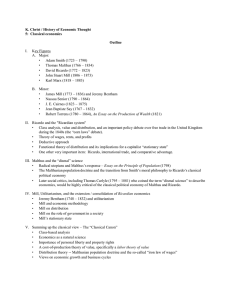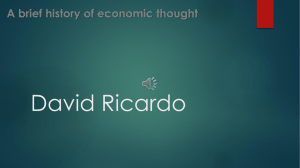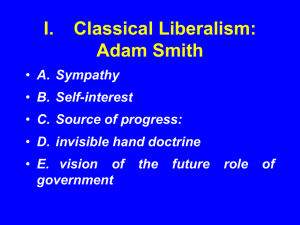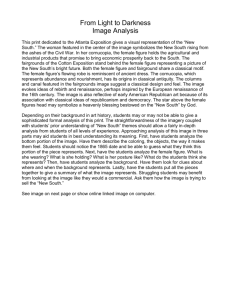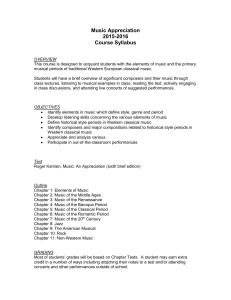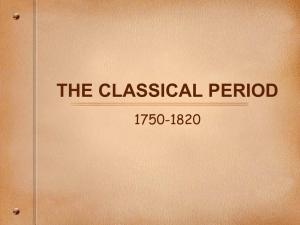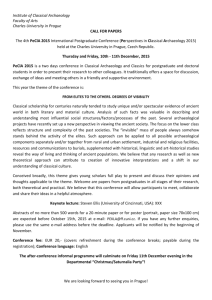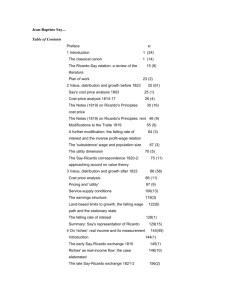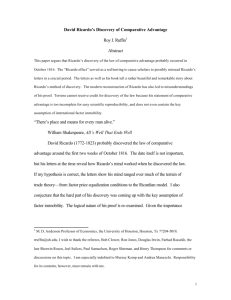The Classical School
advertisement
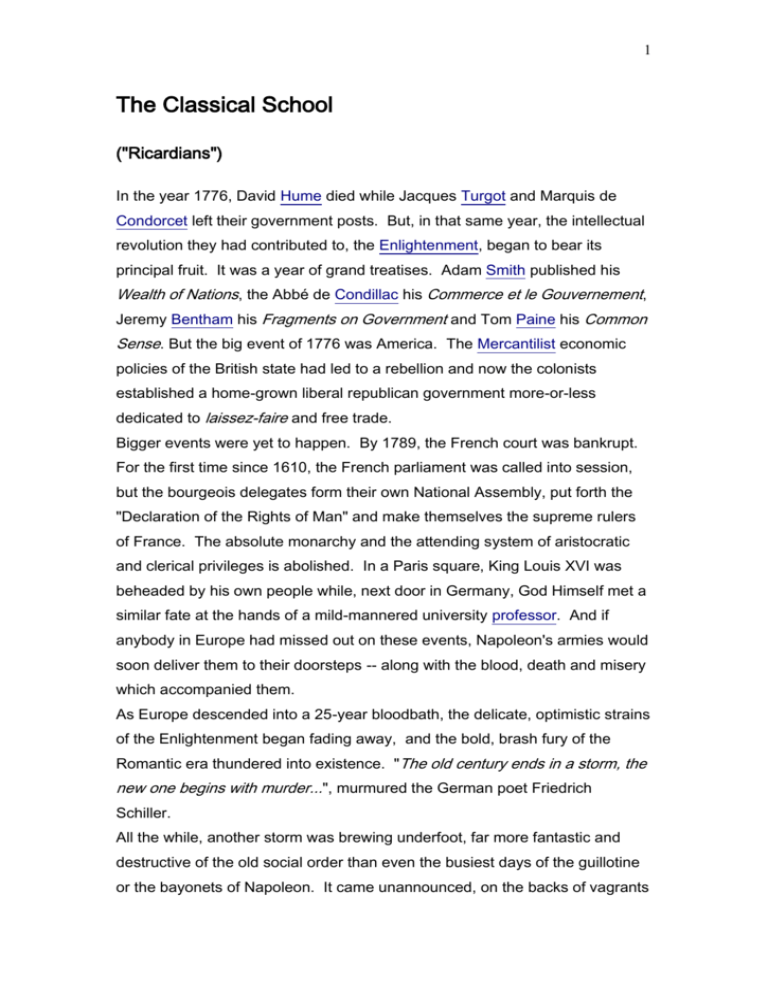
1 The Classical School ("Ricardians") In the year 1776, David Hume died while Jacques Turgot and Marquis de Condorcet left their government posts. But, in that same year, the intellectual revolution they had contributed to, the Enlightenment, began to bear its principal fruit. It was a year of grand treatises. Adam Smith published his Wealth of Nations, the Abbé de Condillac his Commerce et le Gouvernement, Jeremy Bentham his Fragments on Government and Tom Paine his Common Sense. But the big event of 1776 was America. The Mercantilist economic policies of the British state had led to a rebellion and now the colonists established a home-grown liberal republican government more-or-less dedicated to laissez-faire and free trade. Bigger events were yet to happen. By 1789, the French court was bankrupt. For the first time since 1610, the French parliament was called into session, but the bourgeois delegates form their own National Assembly, put forth the "Declaration of the Rights of Man" and make themselves the supreme rulers of France. The absolute monarchy and the attending system of aristocratic and clerical privileges is abolished. In a Paris square, King Louis XVI was beheaded by his own people while, next door in Germany, God Himself met a similar fate at the hands of a mild-mannered university professor. And if anybody in Europe had missed out on these events, Napoleon's armies would soon deliver them to their doorsteps -- along with the blood, death and misery which accompanied them. As Europe descended into a 25-year bloodbath, the delicate, optimistic strains of the Enlightenment began fading away, and the bold, brash fury of the Romantic era thundered into existence. "The old century ends in a storm, the new one begins with murder...", murmured the German poet Friedrich Schiller. All the while, another storm was brewing underfoot, far more fantastic and destructive of the old social order than even the busiest days of the guillotine or the bayonets of Napoleon. It came unannounced, on the backs of vagrants 2 streaming from the English countryside. A few tinkerers had devised a better way to build a spinning wheel -- and civilization was never quite the same after that. The Industrial Revolution in Britain has been tentatively dated from 1760 to 1832. Underfoot, an uprooted and displaced peasantry was transformed into a grim, urban proletariat. The merchants of Bristol and Glasgow morphed into the arriviste industrial capitalists of Birmingham and Manchester. As ever more textile mills dotted the landscapes of England, a new battle was enjoined: calculation versus custom, cotton versus corn, capitalists versus aristocrats, the bourgeoisie versus the gentry, machines versus laborers. The outcome of the battle was predictable. Defeated at home, the traditional ruling classes and their minions departed, rebuilding their privileged lives east of the Suez. The working classes, increasingly miserable and angry, fought back on the factory floor, taking their struggle onto blood-stained squares and, eventually, into parliament. Written during the Enlightenment, the central messages of Adam Smith's Wealth of Nations (1776) -- laissez-faire, the virtues of specialization, free trade and competition, etc. -- seemed an appropriate tune for a gentler era. It did not anticipate the magnitude of the economic and social upheavals that the ravenous industrial era was about to unleash. Furthermore, it was a muddled and inconsistent book. A new edition, corrected, extended and updated, was needed. In the struggle for apostolic succession, three names emerged as strong contenders: Jean-Baptiste Say, Robert Malthus and David Ricardo. They all had different visions for political economy after Smith. Say (1803) wanted to take it back towards the French-Italian demand-and-supply tradition. Malthus (1798, 1820) wanted to add a whole new emphasis, away from the obsessive intricacies of "value" and towards a more macroeconomic (and "dynamic") perspective. Ricardo (1817) wanted to do Smith all over again, but to do it properly this time. Out of all three, David Ricardo turned out to be the most successful and influential. With his 1817 treatise, Ricardo took economics to an unprecedented degree of theoretical sophistication. Ricardo's theory, the 3 most clearly and consistently formalized of them all, became the Classical system. For his efforts, Ricardo acquired a substantial following, particularly in Great Britain. At the core of the "Classical Ricardian" School was the trio of true disciples -- James Mill, J.R. McCulloch and Thomas de Quincey. At an arm's length away, we find Nassau Senior. One may even stretch the school to include Ricardo's (grudgingly updated) old rivals -- T.R. Malthus, Edward West and Robert Torrens. The perspective of the Classical School stretched deep into public opinion in great part through the efforts of the Harriet Martineau's wildly popular books. A group of socialist activists -- Charles Hall, Thomas Hodgskin, John Gray and John Francis Bray -- drew from Ricardo's theory a call for political action. Abroad, on the European Continent, many economists continued working in the Say tradition, notably Rau and the French Liberal School. Say's approach, disputing the labor theory of value and focusing on supply-anddemand instead, was also advocated by a small group of economists at Oxford and Dublin. It was in an effort to stop economics from becoming a mish-mash of theories that John Stuart Mill (1848) wrote his famous textbook, restating the Ricardian Classical doctrines fully and explicitly. Ricardo's system, however, was improved very little by his followers. Perhaps only Karl Marx (1867-94) added insights of any great weight. By the 1860s, however, the Classical School was in a state of siege. The Wages Fund Doctrine, never very solid, was conclusively demolished when F.D. Longe (1866) and W.T. Thornton (1869) forced J.S. Mill to recant it. Simultaneously, Thomas Cliffe-Leslie and English Historicists launched their crusade against Ricardian theory -- accompanied, from afar, by the German Historical School. The Victorian "sages", Thomas Carlyle and John Ruskin, raked the Classical economists over coals in the popular press. The death-knell arrived with the Marginalist Revolution led by William Stanley Jevons (1871), Carl Menger and Leon Walras (1874), which finally provided a clear alternative. The Classical Ricardian system did not last long beyond that. Some amount of reconciliation between the two theories was pursued 4 (or at least discussed) by Alfred Marshall (1890). Other more radical Marginalists, notably Edwin Cannan (1893), concluded that there was nothing in Classical political economy worth salvaging. By this time, the Marxians had disengaged from these developments and went off on their own course. Alone around the turn of the century, Vladimir Dmitriev (1898-1902) began taking steps towards solving some of the more intractable knots that remained in Ricardian theory -- in particular, the "invariable standard of value" that Ricardo had groped for. This was finally accomplished only much later, in Piero Sraffa's remarkable 1960 monograph. Sraffa called for a rolling back of Neoclassicism and the reinstatement of the Classical Ricardian approach. This counter-revolution didn't happen, but there was a revival of interest and research in the Classical Ricardian tradition which continues to progress today under the banner of the "Neo-Ricardian" school. The Early Classical School ("Smithians") Adam Smith, 1723-1790. Dr. James Anderson, 1739-1808. Jeremy Bentham, 1748-1832. James K. Maitland, Earl Lauderdale, 1759-1838 Jane Haldimand Marcet, 1769-1858. Thomas Robert Malthus, 1766-1834. Thomas Tooke, 1774-1858 Colonel Robert Torrens, 1780-1864. Sir Edward F. West, 1782-1828. The Classical School ("Ricardians") David Ricardo, 1772-1823. James Mill, 1773-1836. John Ramsay McCulloch, 1789-1864 5 Thomas de Quincey, 1785-1859 Harriet Martineau, 1802-1876 Nassau William Senior, 1790-1864. John Stuart Mill, 1806-1873. Harriet Taylor, image 1, image 2 The Manchester School Karl Marx, 1803-1883. The Ricardian Socialists Charles Hall, 1745-1825. Thomas Hodgskin, 1787-1869. John Gray, 1799-1850. John Francis Bray, 1809-1895. Continental Classicals Count Antoine-Louis-Claude Destutt de Tracy, 1754-1836. Jean-Baptiste Say, 1767-1832. Jean-Claude-Leonard Simonde de Sismondi, 1773-1842. The French Liberal School Karl Heinrich Rau, 1792-1870. o Textbook on Political Economy , 3 volumes, 1826-37. o German Classical economist, with flavor of Historicism. Closer to Say, Rau did not completely eliminate the role of demand. Friedrich B.W. Hermann, 1795-1868. The Late Ricardians John Elliot Cairnes, 1824-1875 Henry Fawcett, 1833-1884. Millicent Garrett Fawcett, 1847-1929. 6 Henry Sidgwick, 1838-1900. John Shield Nicholson, 1850-1927. - (1), (2) o "A Plea for Orthodox Political Economy", National Review. o A Treatise on Money, 1888. o Principles of Political Economy, 1893-1901 - review o History of English Corn Laws, 1904 - review o The British Economists , 1907. o "The Vagaries of Recent Political Economy", 1913, Quarterly Review o The Neutrality of the United States, 1915. - review o The Revival of Marxism, 1920 - review o British intellectual historian, defender of Classicism against Marshall at Edinburgh. Charles Francis Bastable, 1855-1945. o The Theory of International Trade, 1887. o The Commerce of Nations, 1891. o Public Finance, 1892 - review o Long-term holder of the Whately Chair at Trinity College, Dublin (from 1882 to 1932). International trade theorist and one of the finest expositors of the Ricardian theory. However, critical of Mill's international payments theory. The 20th Century Affiliates of the Classical School The Marxian School Ladislaus von Bortkiewicz, 1868-1931 Vladimir K. Dmitriev, 1868-1913. Adolph Löwe, Wassily Leontief and the Kiel School John von Neumann, 1903-1957. Michal Kalecki, 1899-1970. Piero Sraffa and the Neo-Ricardian School. Maurice H. Dobb and the Neo-Marxian School François Perroux, 1903-1987.
